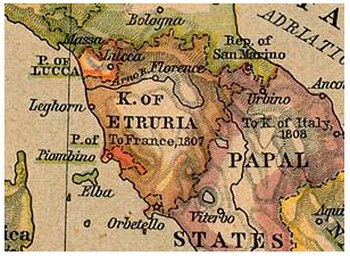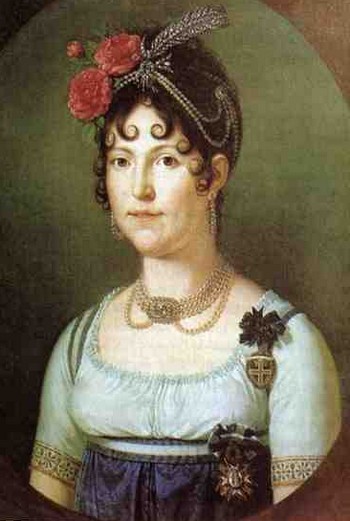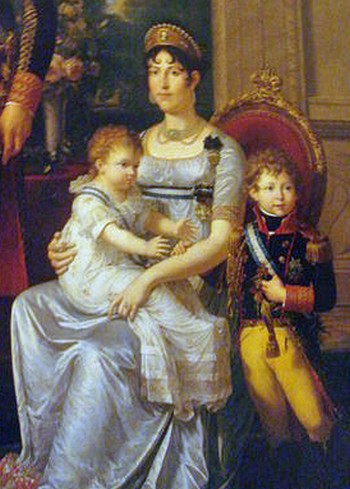Introduction
From 1801 to 1807, after the Napoleon’s conquests, the Grand Duchy of Tuscany became the Kingdom of Etruria,(1) and the information on the local production of playing cards reported and discussed here belongs precisely to that time.
This study has been again carried out in the Archivio di Stato di Firenze, ASF.(2) In a previous note,(3) I already had the opportunity to write a short description and a few comments on this huge archive. This time, my attention has been focused on its section “Ufficio del bollo e marchio di Firenze”, which also contains documents on the Florentine playing card production in the end of the 18th century and in the beginning of the following one.
In particular, registers Nos. 74 to 85 have been studied for this note. These dozen registers - out of which only eleven are actually present) - are kept in two big folders (30x45 cm, 8 cm thick), the first with four registers,(5) the second with the remaining ones.(6)
Only in a few cases, these are registers written one after another with the same format and compilation procedure. It may thus be useful first to provide a short description of these items, before extracting and discussing the relevant data.
Folder 74-77
At first sight, it seems that we are in the presence of three registers here, of a remarkably different shape. However, what appears as the first element of the series is actually formed by two different registers, of the same dimension, bound one after the other. The series can be indicated as follows.
|
Register 74. Registro del Bollo delle Carte da giuoco dall’anno 1801 al 1805. (Actually this register ends with the year 1803.) 284 pages of cm 21x29.
Register 75. Registro del Bollo delle Carte da giuoco dal 1804 al 1805. 298 pages of cm 21x29.
Register 76. Registro del Bollo delle Carte da giuoco dal primo gennaio 1806 a tutto luglio detto. 44 written pages followed by blank ones to page 72, of cm 29x43. (Thus with a dimension of the pages that is the double of the previous ones.)
Register 77. Registro del Bollo delle Carte da giuoco dal primo agosto 1806 a tutto aprile 1808. 36 folios written of cm 23x34, followed by a few blank pages.
|
The first register of the series provides a clear view of what we can find in these books, in the best cases. There is more detail than we are looking for! Every time that a cardmaker arrives at the office in order to stamp his dozen packs, his name, the date, and the exact number of packs are recorded straight away. The second register is the continuation of the first, compiled with the same method; however, it only contains records for a few months, and most of its pages are blank. The continuation in the third and fourth registers is less orderly organised, so that it is more difficult to deduce suitable information for the corresponding years.
Folder 78-85
The account books collected in the second folder are different; whereas the four registers contained in the first folder were compiled one after another in a rather similar way (even if with different formats for the two last ones), here we have a mixed collection of cash books centred around the year 1805, with repeated information.
|
Register 78. Libro di Cassa delle Carte da giuoco dal primo dicembre 1804 al 31 dicembre 1806. 118 pages written, followed by a few blank pages, cm 25x36.
Register 79. Libro di Cassa Generale delle Carte da giuoco dell’anno 1805. 158 pages, blank in part. cm 29x43.
Register 80. Libro di Cassa delle Carte da giuoco. Anno 1806. Pages 1-51 written followed by blank pages, further 7 pages written and other blank pages, cm 25x36.
Register 81. Libro di Cassa per il bollo delle Carte da giuoco. Anno 1805. Pages 1-34 written followed by blank pages to page 50. cm 25x36.
Register 82. Riscontro di Cassa per il bollo delle Carte da giuoco tenuto dal Camarlingo dal primo gennaio a tutto dicembre 1806. 37 pages written and blank to 50 with a 10 folios supplement on cards stamped or stamped again after the law of 24 May 1806, cm 25x36.
Register 83. Licenze per le Carte da giuoco spedite fuori di Stato dal 1804 al 1808. About 10 folios written, followed by 6 blank. cm 21x29.
Register 84. This is missing, and no trace of it is present between Nos. 83 and 85.
Register 85. Registro delle Carte da Giuoco. Anno 1805. Unnumbered folios, about 50, cm 24x31.
|
The records present here usually are not interesting enough for us, because they take into account just the money amounts of the duties paid for stamping the cards, without listing the corresponding amount of card packs involved.
This is only a part of the information and in particular does not provide the actual number and kind of stamped packs. For instance, when we read a payment of L.8 it is impossible to know if this corresponded to a dozen packs of Minchiate, or of Basse, or even to two dozen packs of Piccole.
On the other hand, much of the relevant information could already be deduced from the registers of the first folder. Therefore, in most cases, these books are useless for our search. There are exceptions nevertheless, and in particular we find here a full register of a different kind, No. 83, with records of licences to send cards abroad, which will be used for deriving the corresponding information reported below.
The last register, 85, appears again to belong to the same series of registers 74 and 75: the format is the same, as the same is the procedure followed in its compilation. As it occurred for register 75, however, the interval of time covered in this register is limited to a few months, of 1805 in this case, and the corresponding information is easier to obtain from register 79.
Compilation procedure
One register is used for all the active cardmakers, but in register 74, and in some of the following ones, each cardmaker has his own section within the register, and several blank folios are usually found between different cardmakers.
Actually, for a given cardmaker we initially find at the top of the left page the situation at the starting of the records, with the result of an inspection at the workshop indicating how many packs remain there, and so on. The list of the subsequent productions of packs to be stamped begins at the top of the corresponding right page with different columns dedicated to Minchiate, Basse and Piccole. The number of packs is usually indicated as whole dozens of them, but in some cases additional packs are present, with half a dozen as the most frequent occurrence for those cases. In the same line of date and number of packs, the amount of the stamp duty is recorded.
At the end of each page, we find the sum of all the packs and money amounts listed for the given cardmaker from the beginning of the records to the end of that page. These total numbers are then copied at the top of the following page, with the new total at its bottom, and so on. This procedure appears reliable enough and the calculations seem to be correct.
This methodical procedure has evident advantages for deriving the wanted amounts of the yearly products; there are some small difficulties nevertheless. One is that after the list of the first page on the right, the list continues in the half-page that had remained blank in the previous page, on the left, before passing to the really following page. A second difficulty is that we have to calculate by ourselves the amount of packs for a given year on every occasion when the records for that year finish in the middle of a page.
Finally, there is as a rule no total indicated at the end of the whole list, because it stops in the middle of a page and the totals are only present at the bottom of the pages. This means that again we have to calculate the complete yearly amounts of packs by ourselves (and this may lead to mistakes, particularly if it is I to count).
Dozens and individual packs
Counting by the dozens, we rather frequently read halves, or thirds, or fourths of them, to indicate six, four, or three card packs, respectively. In a few cases, this system has led to a few real mistakes in these registers, such as when we read 1/10, unless this was a conventional way to indicate a single pack - which would be a hardly convenient way, in any case.
I have hesitated whether to indicate the number of dozens, followed by a separate number for the additional packs, when present: this method is actually used in some of these registers in which two adjacent columns are provided for dozens and packs respectively.
In the end, I have decided to use again the unconventional method of non-existing hundredths of a dozen. If for instance one reads in the following tables 10.67 dozens this corresponds to 128 packs. (I agree that multiplying instead all the following numbers by 12 may be the better way.) The following table may help for passing immediately from dozen fractions to more convenient card pack numbers.

Summary of the production
If we compare the situation with that known for other times, we observe that the number of active cardmakers is higher than usual, whereas the number of different kinds of cards produced is now reduced to only three, or even two in some cases. Two of them correspond to “ordinary” cards, Basse and Piccole, which can be considered roughly to represent almost one half each of the whole production. The third and last kind of cards is actually that of Minchiate, the traditional Florentine cards, which are still produced, but clearly in a much lower fraction, often less than ten percent of the total.
We have to remember that we are observing here the market of the playing cards from the point of view of the administration, which derived a substantial income from the stamp duties imposed on any card pack to be sold. In other words, what we observe is only a preliminary stage, required before the packs can be sold and used. The money amounts that we see in these records are not at all the prices of the card packs, but just the stamping duties.
Now, the possible cases were different. There could be, at least since 1806, some legal trade of playing cards produced abroad. Foreign cards that entered the territory had to pay the corresponding customs taxes and then also the stamping duties if they had to be used locally.
From the point of view of the Ufficio del Bollo, also the packs produced by the Florentine cardmakers were differently handled if they were addressed to local utilization, or instead they were made for exporting. We find here the total amount of cards stamped for local use and, usually in other registers, the amount of packs sent abroad. In some cases, however, the two contributions are listed together, at least in part.
From the detailed information contained in the registers indicated, I have derived the yearly production of the Florentine cardmakers for local use, as singly summarised in the following tables for the three different kinds of playing cards. (One has to remember that these numbers correspond to dozen packs, with additional packs, when present, indicated here conventionally as dozen fractions.)
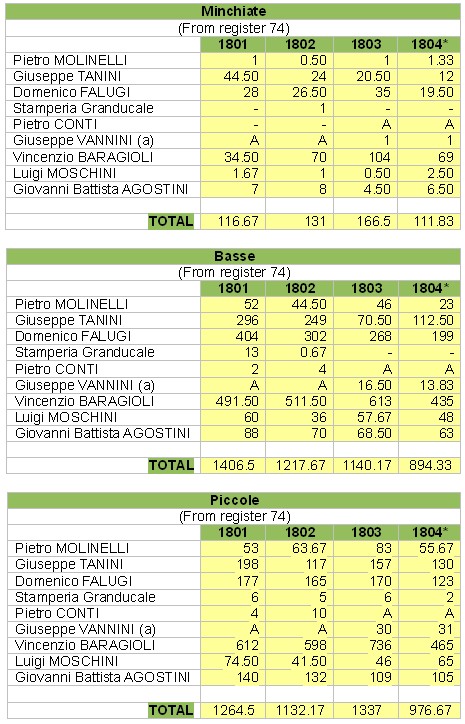
* The records for 1804 in register 74 usually finish off at the end of August.
The absence of the corresponding cardmaker in the records of that year is indicated with A.
(a) Vannini is first recorded on 22 June 1803.
Some further packs stamped in the last months of 1804 can be obtained from other registers, but I fear that it is impossible to reconstruct the records of the whole year correctly.
For the year 1805, instead of using the parts of that year recorded in registers 75 and 85, I have preferred to use register 79, where records for the whole year can be found.
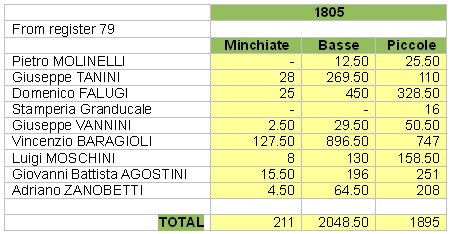
The situation for the years 1806 and 1807 is much more confuse and the corresponding information has not been deduced in a reliable way. It must be noted that the different registers have not been compiled in the same way. I am thus not sure to have derived the data reported here from comparable sets of records; therefore, caution is required if one compares the information from different registers.
The production of year 1806, in particular, can only be derived from parts contained in different registers, and I am not even certain that summing these parts is correct. Therefore, I have separately reproduced here parts found in different registers.
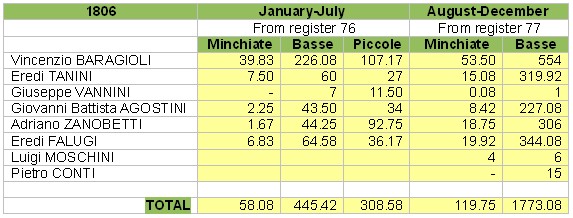
Starting with the second half of 1806 we do not find the Piccole column any longer. The reason can be found in the new law of 1806, see below, which suppressed the reduced duty on Piccole. In a few cases, however, it is indicated that some dozen packs in the Basse column actually were Piccole. If we combine Piccole with Basse and sum the two parts of the year, the result for 1806 in dozen packs would be 177.83 Minchiate and 2527.08 Basse.
The reduction from three to two columns for the kinds of cards continues in the following years.
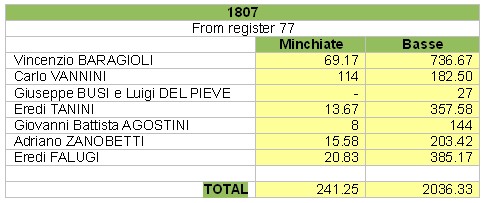
In register 77 we also find records for the initial months of 1808; I have taken them into account, even if they do no longer corespond to the Etruria Kingdom of the title. The last records contained in this register provide the data summarised in the following Table.
1808 January to April
From register 77
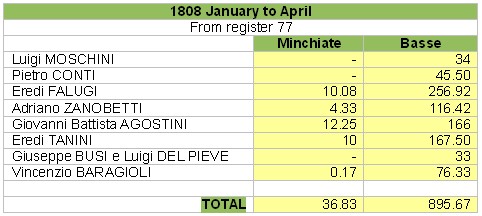
The new law of 1806
A new law was promulgated on 24 May 1806, containing new rules for controlling the production and the utilisation of playing cards. Collections of the laws of Tuscany have been published as long series of books, but these few years are not included in the time covered by the usual collections.
I had to leaf among other documents of the “Ufficio del bollo e marchio di Firenze” kept in the ASF and I could find the printed bill containing this law in another folder of the same office.(7)
On behalf of King Carlo Lodovico I (six years old by then), the Queen Regent of Etruria, Maria Luisa, signs on 24 May 1806 the new law, containing twenty-three articles. Let me summarise the essential elements.
1) In each pack a new stamp has to be printed, on the jack of clubs, or in card XXX for Minchiate. 2) The shape of the stamp is octagonal, with a crown above and the inner part of the royal coat of arms inside, surrounded by the text “Carte d’Etruria”. 3) The stamping duty is 1 Paolo for any kind of cards. 4) All cards still to be sold, even if regularly stamped, have to be stamped again. This is free of charge, except for Piccole, because they had been stamped at half duty earlier on. 5) Cards to be exported are excluded from stamping duties, but the export must be authorised and controlled. 7) The new rules and duties are extended to marginal zones of the country, which were exempted before.
8) Cards can only be produced in Florence. 10) Cards entering the country from abroad must pay the duties for transit. 11) In addition to paying customs duties, any foreign cards used in the country must be stamped as the local products. 16) Authorised cardmakers must keep their printing blocks in the building of Ufficio del Bollo, print their cards there, and come again into the office after finishing their job for stamping the packs. 23) The law has full effect from 1 August 1806.
Supplemento for cards stamped again
As a result of the new law and procedures we observe new kinds of records, as supplements to the ordinary registers.
The Supplemento records can be found in two registers, 80 and 82; the former list is less useful, because it only provides information on the amounts of stamping duties. We find here many names of the persons involved, mostly unknown, who probably included detailers who had to renew the stamps on the packs that they still had on sale.
These records have dates from 1 July to 31 October 1806 and the total amount paid for renewing the stamps is given as L. 696. In register 82 we read the corresponding amounts of card packs involved, and the total, in dozens, is: 86.42 Minchiate, 339.42 Basse, 202.08 Piccole.
Information on cards exported
It may be of some interest to get an idea of the playing cards exported. Already in register 74 we find a few pages at its end with records of cards exported. These packs have been recorded together for the various cardmakers and I have only reported below the total amount. It is evident that Basse provided by far the greatest contribution.

Only for Minchiate, I have deduced the individual contributions of the cardmakers: approximately (namely, neglecting some additional packs) we find the values of the following Table.
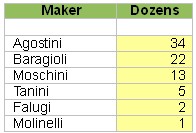
The participation of the various cardmakers is not as expected. That Baragioli was among the most active makers is not surprising, but the case of Agostini is exceptional, as if he mainly, or even completely, produced Minchiate just for export.
This situation of separate accounting for cards exported continued in the following years and register 83 is entirely devoted to records of licences to send cards abroad. These 130 licences are charged at s.8 each and are individually numbered in four subsequent sections, as follows.

All entries are listed with destination, contents, customs offices where the cards have to be shown, and usually also the name of the person who brings the cards there. Here again Basse provide the major contribution.
I have summarised in the Table below the packs of Minchiate included in those shipments.
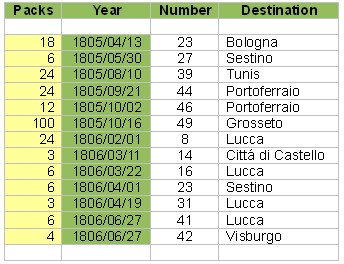
Conclusions
I have studied eleven registers of “Ufficio del Bollo e Marchio di Firenze”, for the years 1801-08, kept in two folders of Archivio di Stato di Firenze; they contain records of playing cards made in Florence and stamped by the official administration.
Seemingly, it should be possible to deduce from these registers the complete Florentine production from 1801 to 1808. However, due to the difficulty to extract suitable values, the information that I could derive from the documents is not equally complete and reliable for the different years.
The whole set of data reported should better be confirmed by a more exhaustive study of the corresponding documents. In particular, all the information on the actual trade and utilisation of playing cards is missing here and should be derived from different sources.
The kinds of cards produced at the time had been reduced to only three different kinds, Minchiate, Basse, and Piccole, with the last kind practically disappearing in the last years taken into account.
Minchiate clearly represented a small part of the production, and in some cases (in particular, for cardmaker Agostini) a remarkable part of them was apparently produced for export. Some information is reported on Minchiate exports, including their destination in the years 1805 and 1806.
Footnotes:
(1) Wikipedia: Kindom of Etruria
(2) archiviodistato.firenze.it
(3) Franco Pratesi: 1451 – ONE COMMON PACK OF TRIONFI, (2012)
(4) Franco Pratesi: 1791 – PRODUCTION AND SALE OF PLAYING CARDS IN TUSCANY, (2012)
(5) ASF, Ufficio del bollo e marchio di Firenze, No. 74 to 77.
(6) ASF, Ufficio del bollo e marchio di Firenze, No. 78 to 85.
(7) ASF, Ufficio del bollo e marchio di Firenze, No. 28.
|
|










